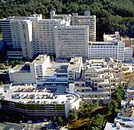
By Fortune Meriwether
Students, faculty, health professionals, researchers and members from the community gathered together on Jan. 31 at Cole Hall to participate in one of 1,600 national teach-ins that occurred during that week.
The teach-ins were a part of Focus the Nation, a national campaign to discuss and evaluate America's role in global climate change.
Steve Wiesenthal, associate vice chancellor of Capital Programs and Facilities Management, gave a presentation on the ways in which the UCSF campus addresses sustainability. Wiesenthal began by stating that UCSF, as a health sciences institution, has an obligation, commitment, desire and interest to operate in an environmentally sustainable manner.
The actions of UCSF have the potential to benefit the local community because the academic institution and health facilities represent the second largest employer in the city of San Francisco, Wiesenthal said. In addition, UCSF actions impact the world because the institution has high visibility in the health sciences arena.
UCSF has prioritized environmental sustainability for economic, environmental and social reasons, Wiesenthal said. UCSF adopted environmental sustainability because there are great economic benefits that arise when the institution is more efficient, conserves natural resources, reduces waste, and promotes a healthy workplace and community.
UCSF also has experienced a reduction in energy costs as a result of being environmentally sustainable. The projected energy cost savings for 2007-2008 are $1 million, according to Wiesenthal.
The UCSF Sustainability Committee was established by Wiesenthal in 2003, signifying a growing trend toward greener practices across the entire UC system. Unlike sustainability committees at the other UC campuses, UCSF's committee is led by staff members representing a cross-section of the campus community.
The committee has a number of working groups that address issues such as climate change, procurement (take-back programs for computers, Styrofoam boxes, remanufactured toner cartridges), transportation and budget.
In fact, UCSF is seeing a whole culture change in the way in which the University does its budgeting for projects such as new buildings. When planning for a new building, UCSF tries to decrease costs to the University and also decrease the negative impact on the environment, Wiesenthal noted.
UCSF aims to keep cost-per-square-foot costs low while at the same time looking at the overall life cycle cost of the building project (as opposed to taking into account only the initial costs of the building). UCSF also tries to incorporate green building technologies and materials, which is called for in UC's Policy on Sustainable Practices. That policy establishes a set of ambitious goals to advance environmental practices at UC campuses, ranging from efficient energy use to innovative, sustainable purchasing practices.
Green Building
UCSF has been working to incorporate green building techniques in campus and medical center projects. For example, UCSF recently installed the largest solar power installation in the UC system, located at Mission Bay on the roof of the Third Street parking structure. The solar energy system began operating on Jan. 10 and generates 250kw of solar energy.
UCSF also completed the renovation of a lab in the Health Sciences West building at the Parnassus campus, becoming its first project officially certified by the US Green Building Council's Leadership in Energy and Environmental Design (LEED) rating system.
In addition, UCSF Medical Center selected Anshen + Allen in association with William McDonough + Partners for the design of the Mission Bay medical center. William McDonough + Partners is a leader in sustainable and eco-effective design. The medical center at Mission Bay is expected to be built by 2014.
UCSF faces many challenges regarding environmental sustainability. The University layout is decentralized, so environmental efforts have to be coordinated across the different UCSF sites and departments. The research facilities and hospital are also utility intensive and require large amounts of resources.
UCSF has taken a number of approaches to improving efficiency and reducing greenhouse gas emissions. In 1999, UCSF recycled 14 percent of its waste, the recycling rate increased to 43 percent in 2007. The compost program on campus currently diverts 5 percent of the garbage away from landfills. UCSF also has reduced greenhouse gases emissions by 5,000 tons and conserved 3 million gallons of water per year with the installation 75 waterless urinals, Wiesenthal pointed out.
The campus is also committed to decreasing auto traffic, and it has expanded its alternative transportation program. The biking capacity in 2003 consisted of one bike cage and one bike locker; in 2008, the number increased to five bike cages and 55 bike lockers. In 2003, UCSF saw more than 2 million shuttle bus boardings; the number increased to 4 million shuttle bus boardings in 2007. As for ride sharing, there were 30 vanpools in 2003, the number increased to 50 vanpools in 2007.
Related Links:
Focus the Nation Featured on TV20
UC Continues Progress in Sustainability Practices
UCSF Sustainability Committee
UC Sustainability

